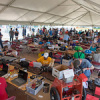There are loads of great development platforms out there, but some of the most popular are the Arduino boards. Arduinos have become increasingly popular because of their user-friendly IDE, a huge support system with tons of example code, and their simplicity of use. Arduino is a great gateway board to get started with embedded electronics and can also be used in complex projects. Today we have a great beginner video if you're just starting to explore the world of Arduino. Check it out:
This video will guide you through setting up your Arduino with your PC or Mac. Oddly enough, this might be the most confusing part of using Arduino - the basics of getting started. So Dave Stillman (of product post fame) breaks it down step-by-step. Please feel free to leave any questions or comments below. Enjoy!








Thanks Sparkfun! For telling me about Arduino. I got my first board a week ago. Very well made and well thought out boards.
I met Dave at a mini maker faire in VT last month and he grimaced when I pointed and said "It's Product Post Dave!" It's hard to get other gigs once you've been type cast. Nice to see the acting career go in another direction. This one will help me with my own efforts to spread the Arduino love.
Think I may have skipped a step when I started using my arduino about four months ago, but now think I know what I skipped. Thanks to this video. :-)
Nice Video Dave,
It origionally took me about a couple of hours to be confident to just get the blink example going especially since i didn't even know what an LED was. Have had the arduino mega 1280 for a couple of years and started on a long journey since then. The only thing that i could do was plug the computer into the wall. Now, I have made my first autonomous object avoidance robot, and recently made (last night) made my first laptop wireless controlled robot using the Xbee modules, arduino, XCTU program, and a motor shield. I am still learnig, and will continue to learn but that is the nature of doing things and making things. Just want to say "Thanks Sparkfun, you put in a SPARK in my neurons" and thanks Dave, this is a video that is long overdue for sparkfun. Now, get back to work on more examples, "just make a variety of examples" for a variety of projects, especially for all of your products. Sorry, being selfish. Thanks again.
What kind of coffee mug is that next to the windows laptop??
Nice background pic Dave :-)
I see da Stillz has warmed up to the camera! Sadly, there was no mention of the 'A' hole, this time (although he came close with the "'B' end" comment...). The BEST part is about 4:15... his expression after he says "Now, let's talk about the Mac...". LOL
I'm a bit miffed that you didn't include installing Arduino on Linux in the video. Arduino on Linux is more like MAC than Windows, but the process is a bit different. Also YUCK Windows 8! (I'll wait for the dust settles on this one before I think of trying Win 8, but maybe on VM under Linux).
Also Arduino does NOT compile sketches into "BYTE Code" to upload to the board. This ain't Java and the Arduino does NOT have JVM firmware on it. It's pure AVR binary folks! There IS Java inside of the IDE but that runs ONLY on the PC, the IDE is written in Java. (What's strange is that there are two different versions for both Linux and Windows, one for 32 bit and one for 64 bit. I assume that's only for the included AVR tools not the IDE since Java byte code should be transparent between 32 and 64 bit versions of the JDM)
I would think its safe to say most anyone running Linux should be capable of installing Arduino.
Remember JBC isn't the only kind of bytecode out there. Although it isn't technically correct, I've heard the Hex files that are generated by the AVR compiler referred to as bytecode as well.
If you're interested in running Java on AVR chips, though, you might have a look at NanoVM.
And about Linux, I run Ubuntu on my home computer and have Arduino and all that jazz installed... The truth is, once you've got Linux running the way you like, installing Arduino will probably be one of the easier things you do. Because the barrier to entry for systems like Win and OSx is so low, we think we're more likely to see users from those systems that need a little help.
A bunch of us here are Linux fans
Well since Arduino version 1.0.0 installing the IDE on Linux is much easier since the required AVR tools are included. Earlier versions required installing the required AVR tools packages. Also the earlier Arduino IDE versions were a bit behind in that they relied on deprecated syntax features of older versions of avr-gcc. You also need to have the right version of Java installed, but it seems like most Linux distros actually have the right one. (I've had problems with Wiring complaining about Java though....) Some distros might have packaged the Arduino IDE around an installer, otherwise you will have to create a custom launcher on your desktop (I put one in Cario-Dock on my desktop).
I would agree that most long time Linux users probably could figure it out for themselves, but thanks to Ubuntu, Mint, and a few other distros Linux is now very easy to install resulting in users that might need a bit more help.
I wait intil the dust settles to try anything! The price drops dramatically. Take the iphone for instance, the Iphone costed as much as the Iphone 5 does now. Wait a while and save money.